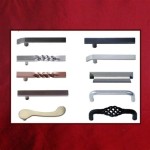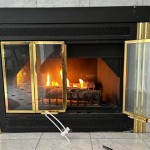Black Paint for Inside Gas Fireplaces: Aesthetics, Safety, and Application
Gas fireplaces offer a convenient and efficient way to add warmth and visual appeal to a living space. The aesthetic of a gas fireplace often hinges on the interior appearance surrounding the gas logs and burners. Over time, the original interior of a gas fireplace can become discolored or stained due to heat exposure and combustion byproducts. Applying black paint specifically designed for high-temperature environments is a common method to refresh and enhance the fireplace's visual presentation.
The use of black paint inside a gas fireplace is not solely about aesthetics. Black surfaces absorb light, which can enhance the perceived flame brightness and create a more dramatic visual effect. The dark backdrop can make the flames appear larger and more vibrant, contributing to a more realistic and inviting fireplace experience. Furthermore, a fresh coat of black paint can cover any existing imperfections or discoloration, resulting in a cleaner and more uniform look.
Understanding the Importance of Heat-Resistant Paint
The primary consideration when selecting paint for a gas fireplace is its heat resistance. Standard house paints are not suitable for this application. They will likely blister, peel, and emit noxious fumes when exposed to the high temperatures generated by a gas fireplace. Only paints specifically formulated to withstand high temperatures should be used. These paints are engineered with specialized resins and pigments that can maintain their integrity and color at sustained temperatures ranging from 500°F to 1200°F or higher, depending on the product.
High-temperature paints are typically available in spray cans or as liquid paints that can be applied with a brush. Spray paints offer a quicker and more even application, especially on intricate surfaces. However, liquid paints may provide better coverage and durability in some cases. The specific paint type and application method should be chosen based on the individual fireplace design, the desired finish, and the user's comfort level with the application process.
It is crucial to carefully review the manufacturer's specifications for any high-temperature paint before application. The manufacturer's instructions will outline the recommended surface preparation, application techniques, drying times, and curing procedures. Following these instructions precisely is essential to ensure the paint's proper adhesion, durability, and heat resistance.
Using an inappropriate paint can lead to several problems. Aside from the aesthetic degradation of the paint itself (blistering, peeling, cracking), the fumes released from regular paint burning off can be hazardous to human health. The off-gassing can release volatile organic compounds (VOCs) into the air, potentially causing respiratory irritation and other health issues. Moreover, the peeling paint can create a fire hazard if it falls onto the burner or pilot light assembly.
Preparation is Key: Ensuring Proper Application and Safety
Proper preparation is paramount before applying any paint to the interior of a gas fireplace. This process involves cleaning the surfaces to be painted, masking off areas that should not be painted, and ensuring adequate ventilation during the application and curing phases. Neglecting these steps can result in a subpar finish, potential safety hazards, and reduced paint longevity.
The first step is to thoroughly clean the interior surfaces of the fireplace. This involves removing any loose debris, dust, soot, or grease. A wire brush can be used to remove stubborn deposits. A degreasing cleaner might be necessary to eliminate any oily residue. Ensure that all cleaning agents are completely removed and the surfaces are dry before proceeding. Allowing the surface to fully dry prevents moisture from being trapped beneath the paint, which could lead to blistering or peeling later on.
Masking off the areas that should not be painted is equally important. This includes the gas logs, the burner assembly, the pilot light assembly, and any other components that should remain unpainted. Use painter's tape and masking paper or plastic sheeting to create a clean and precise barrier. Precise masking ensures a professional-looking finish and prevents accidental overspray onto sensitive components.
Adequate ventilation is critical. Applying high-temperature paint, even those with low-VOC formulations, can release fumes. Working in a well-ventilated area helps to minimize exposure to these fumes. Open windows and doors to create cross-ventilation. A respirator mask specifically designed for paint fumes is highly recommended to protect the respiratory system. This is especially important during the curing process, when residual fumes may be released as the paint fully hardens.
Before applying any paint, it is prudent to consult the gas fireplace manufacturer's instructions. Some manufacturers may recommend specific types of paint or discourage painting certain components altogether. Adhering to the manufacturer's recommendations helps to ensure the continued safe and efficient operation of the fireplace and avoids voiding any warranties.
Selecting the Right Paint and Application Techniques
Choosing the correct type of high-temperature paint and applying it using proper techniques is essential for achieving a durable and aesthetically pleasing finish. Factors to consider include the paint's temperature rating, its finish (matte, satin, or gloss), and its application method (spray or brush).
The temperature rating of the paint should exceed the maximum temperature expected inside the fireplace. While most gas fireplaces do not reach extremely high temperatures, selecting a paint with a higher temperature rating provides an added safety margin. A rating of at least 1000°F is generally recommended for gas fireplace applications. Review the fireplace's specifications and any available temperature data to make an informed decision.
The desired finish is largely a matter of personal preference. Matte finishes tend to absorb more light, creating a darker and more uniform look. Satin finishes offer a slight sheen, providing a balance between light absorption and reflection. Gloss finishes reflect more light, resulting in a brighter and shinier appearance. The choice of finish can significantly impact the overall aesthetic of the fireplace. A matte black finish is often preferred for gas fireplaces as it minimizes glare and enhances the flame visibility.
When applying spray paint, hold the can approximately 8-12 inches from the surface and use smooth, even strokes. Avoid applying too much paint in one coat, as this can lead to runs and drips. Instead, apply several thin coats, allowing each coat to dry completely before applying the next. Overlapping each stroke slightly ensures even coverage and prevents any bare spots. Always follow the manufacturer's instructions regarding drying times between coats.
If using liquid paint, use a high-quality brush designed for high-temperature paints. Apply the paint in thin, even coats, working in one direction. Avoid applying too much pressure, as this can create brush strokes and uneven coverage. Allow each coat to dry completely before applying the next. Multiple thin coats are generally preferable to one thick coat, as they provide better adhesion and durability.
After applying the final coat of paint, allow the fireplace to cure completely according to the manufacturer's instructions. This often involves a period of several hours or even days during which the paint fully hardens and bonds to the surface. During the curing process, it is essential to maintain adequate ventilation to allow any residual fumes to dissipate. Avoid using the fireplace until the paint is fully cured, as this can damage the finish and release harmful fumes.
Proper application and curing techniques are crucial for achieving a long-lasting and aesthetically pleasing finish that can withstand the high temperatures generated by a gas fireplace. Adhering to the manufacturer's instructions and taking the time to prepare the surfaces properly will result in a professional-looking and safe outcome.

How To Paint The Inside Of A Fireplace Simple Upgrade Maria Louise Design

How To Spray Paint Fireplace Interior The Diy Playbook

How To Paint The Inside Of A Fireplace Sarah Joy

Painting The Interior Of A Fireplace Shine Your Light

Paint The Inside Of Your Fireplace And Change Grout Color

What Kind Of Paint To Use On The Inside A Fireplace Hunker

Fireplace Makeover Spray Paint Magic

Fireplace Makeover Spray Paint Magic

30 Gorgeous Painted Brick Fireplace Ideas

Expert Tip Paint The Fireplace Black
Related Posts








